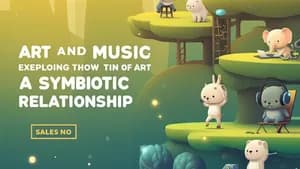This article examines how artists and musicians have used the concept of space and perspective to create depth, dimension, and a sense of immersion in their work. It compares methods used in painting, sculpture, and music composition to manipulate the audience's perception of space.
Understanding Space in Visual Arts
When we talk about space in art, we're not just referring to the physical canvas or the area a sculpture occupies. We're talking about the illusion of depth, the sense of distance between objects, and the way the artist guides your eye through the artwork. Think about a landscape painting: how does the artist make the distant mountains appear smaller and hazier than the trees in the foreground? This is achieved through the skillful use of perspective. Linear perspective, for instance, uses converging lines to create the illusion of depth, with lines receding towards a vanishing point on the horizon. You can practice this by sketching simple cubes and rooms, focusing on how lines converge to give the illusion of three dimensions on a two-dimensional surface. Experiment with different vanishing points to see how this changes the perspective and the overall feel of your drawing. Atmospheric perspective is another valuable technique that utilizes changes in color and detail to create depth. Objects further away appear lighter, less detailed, and often have a bluish tint. Try painting a simple outdoor scene and observe how these techniques help convey the depth of the landscape. Observe masterworks like Leonardo da Vinci's 'The Last Supper' to study how he uses linear perspective to draw the viewer's eye to the central figure of Christ. Analyze the placement of figures and objects, noting how perspective guides your visual journey through the painting.
Perspective in Sculpture and Installation Art
Space isn't just a concern for painters; sculptors also masterfully manipulate it. Consider the monumental sculptures of ancient Greece and Rome – these works often used scale and placement to create a sense of grandeur and power. The sheer size of these statues in relation to the viewer creates an overwhelming sense of space and presence. Modern and contemporary sculptors push the boundaries further, often incorporating the surrounding environment into their work. Think of land art or installations that utilize vast outdoor spaces as part of the artwork itself. They might use perspective to make the viewer feel dwarfed by the scale of the work, or conversely, to create an intimate and enclosed space within a larger environment. If you’re interested in sculpture, think about how you might use space in your work – consider creating a piece that plays with scale, or one that interacts with its surroundings in unexpected ways. Explore different materials and their spatial properties. A simple exercise is to build small maquettes – scale models of sculptures. This helps to visualize how different materials and elements interact spatially. Pay close attention to positive and negative space – what your sculpture is, and what the space around it is. This interplay is key to shaping the viewer’s experience.
Space and Perspective in Music Composition
While not directly visual, music also uses concepts analogous to space and perspective. In music, 'space' refers to the sonic environment – the texture, density, and layering of sounds. Think about a symphony orchestra: the different instrumental sections create layers of sound that exist in relation to one another. The composer might place certain instruments in the foreground, creating a sense of focus, while others recede into the background, adding depth and richness to the overall sonic texture. The use of dynamics (loudness and softness) and timbre (the unique quality of each instrument) also contributes to the perception of sonic space. A crescendo, for instance, can create a sense of expansion, moving the sound 'forward', while a diminuendo creates a sense of recession, drawing the sound 'backward'. You can explore this by listening to orchestral pieces and focusing on how the composer arranges the instruments in space, changing the balance and dynamics. Practice arranging simple compositions for multiple instruments, paying attention to how the different sounds interact and create a sense of depth. Analyze the scores of classical composers like Bach, whose contrapuntal techniques create complex layers of sound, or Debussy, whose impressionistic music creates atmospheric sonic landscapes. Pay close attention to how the composers use instrumentation, rhythm, and harmony to create a sense of musical space.
Combining Elements: Interdisciplinary Approaches
The concepts of space and perspective are not confined to individual art forms. Many artists and composers have explored the intersection of these ideas, creating truly immersive experiences. Consider the use of music in film scoring: the music often reinforces the visual narrative, expanding or contracting the perceived space on screen. A quiet, intimate musical passage might emphasize a moment of solitude, while a grand, sweeping orchestral score might accompany a wide shot of a vast landscape. Similarly, visual art can inspire musical compositions, and vice versa. You could try creating a visual artwork inspired by a musical piece, paying attention to how the musical dynamics and textures translate into visual forms. You might also explore the idea of creating a collaborative project, where visual artists and musicians work together to create a multi-sensory experience that integrates visual space and sonic space.
Conclusion
Mastering space and perspective in art and music requires careful observation, experimentation, and a deep understanding of the underlying principles. By studying the works of masters, practicing various techniques, and engaging in cross-disciplinary explorations, you can develop your ability to create compelling and immersive works that captivate your audience. Remember that the journey of learning is ongoing, full of experimentation and discovery. Don’t be afraid to make mistakes; they are valuable opportunities for growth and learning. The key is to remain curious, to keep exploring, and to never stop learning.

